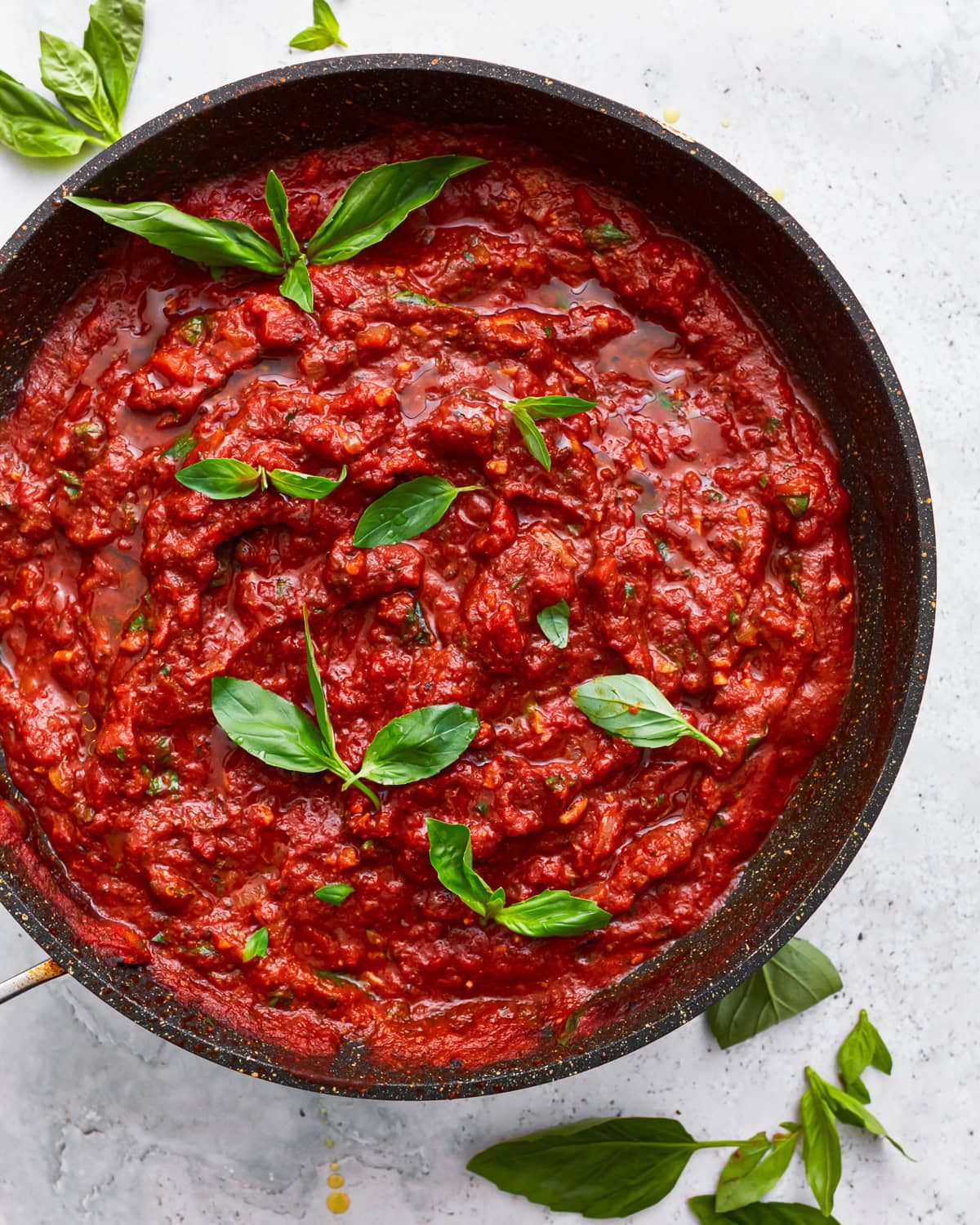Gluten-Free Spaghetti Sauce
Published
I’ve been making this homemade gluten-free spaghetti sauce for as long as I can remember. This easy dinner recipe uses simple pantry staples and a sprinkling of fresh herbs to create a tangy, flavorful gluten-free sauce perfect for topping pasta, chicken, or pizza. It’s so easy to make and tastes better than any store-bought sauce I’ve ever tried! I usually double or even triple this recipe and freeze the extra sauce for later.

Gluten-Free Spaghetti Sauce Recipe
Store-bought sauces are great in a pinch, but nothing beats the fresh taste of homemade sauce. I don’t need to worry about gluten-containing ingredients or unwanted additives when making this gluten-free spaghetti sauce from scratch. I use three different types of tomatoes – crushed, paste, and sauce – and mix them with garlic, onion, Parmesan cheese, and a handful of herbs to create the richest, heartiest, and delicious sauce I’ve ever tasted! My family love it served over homemade gluten-free pasta or almond flour pasta.
Ingredients
- Olive Oil: Adds an extra layer of flavor to the sauce.
- Onion & Garlic: These aromatics add depth and help create a flavorful base. Dice them finely to evenly distribute the flavor throughout the sauce.
- Crushed Tomatoes: Choose a brand with no added herbs or flavorings if possible.
- Tomato Sauce: Adds to the body of the sauce.
- Tomato Paste: This is a concentrated form of tomatoes that adds a rich, intense flavor.
- Sugar: Balances the acidity of the tomatoes. Add more or less, depending on your preference.
- Parmesan Cheese: If you’ve never added Parmesan to your sauces before, you have to try it! It adds a saltiness and creaminess that brings everything together. If you’re vegan or dairy-free, you can omit the cheese.
- Dried Herbs & Seasonings: Add dried basil, dried oregano, salt, black pepper, and red pepper flakes to the sauce before leaving to simmer for 30 minutes-1 hour. The longer the sauce cooks, the more flavorful it will be.
- Fresh Basil & Parsley: I stir in fresh basil and parsley before serving. It makes the sauce smell and taste amazing!
- Ground Meat (Optional): This recipe is delicious as a meatless sauce, but if you want to add some protein, ground beef, turkey, or Italian sausage are great options. Your favorite vegetarian/vegan meat alternative will also work.

Tips and Suggestions
- You can sneak extra veggies into the sauce by sautéing mushrooms, zucchini, spinach, or bell peppers and adding them in.
- To make the sauce thicker, let it simmer uncovered until it reaches your preferred consistency. To thin it out, add a little water.
- If the sauce is too acidic for your tastes, add a bit more sugar to neutralize the acidity. Start with a small amount, stir everything together, and taste before adding more.
- The longer the sauce simmers, the more flavorful it will become. If you have time, let it simmer on low heat for an hour.
- Use a hand blender or food processor to puree the sauce if you prefer a smoother consistency.
Is Spaghetti Sauce Gluten-Free?
Most jarred and canned spaghetti sauces are gluten-free. It’s usually what the sauce is served with that determines its gluten content, such as pasta or meatballs. But please always check your labels, especially for different flavored sauces. I much prefer making my own sauces because I can control what goes into them and can customize the flavor to my liking.
That said, some brands that sell gluten-free sauces are:
- Rao’s
- Prego
- Ragu
- Barilla
- Primal Kitchen
However, just because some sauces from a brand are gluten-free doesn’t mean they all are. Always double-check your labels!

Can I Use Fresh Tomatoes?
Yes, you can use fresh tomatoes. Blanch, peel and crush about 10-12 medium-sized tomatoes to replace the canned crushed tomatoes. You may need to simmer the sauce a bit longer to achieve the desired thickness.
Serving Suggestions
If I could dip, spread, or drizzle everything in this sauce, I probably would! Here are some of my favorite ways to enjoy this easy recipe for gluten-free spaghetti sauce:
- Over gluten-free gnocchi, spaghetti, or pasta with gluten-free meatballs
- Layered in gluten-free lasagna
- To make gluten-free pizza
- For dipping gluten-free focaccia or gluten-free mozzarella sticks
- To make a chicken Parmesan
- Over zucchini noodles for a low-carb dinner option
Storage Instructions
Let the sauce cool completely before storing it in an airtight container in the fridge for up to 4 days. It also freezes perfectly and is a great make-ahead dinner option. Use a freezer-safe container or bag and freeze for up to 3 months. Thaw in the fridge overnight before reheating gently on the stove or microwave before serving.

More Gluten-Free Sauce Recipes to Try!
Gluten-Free Spaghetti Sauce

Ingredients
- 2 tablespoons olive oil
- 1 medium onion, finely chopped
- 3 cloves garlic, minced
- 1 can (28 ounces) crushed tomatoes
- 1 can (15 ounces) tomato sauce
- ¼ cup tomato paste
- 1 tablespoon sugar
- 2 teaspoons dried basil
- 1 teaspoon dried oregano
- ½ teaspoon salt
- ¼ teaspoon black pepper
- ¼ teaspoon red pepper flakes
- 2 tablespoons chopped fresh parsley
- 2 tablespoons chopped fresh basil
- 2 tablespoons grated Parmesan cheese
- 1 pound (optional) ground beef, turkey, or Italian sausage
Instructions
- In a large skillet or saucepan, heat the olive oil over medium heat. Add the chopped onion and sauté for about 3-4 minutes until softened. Add the minced garlic and cook for another minute, stirring frequently, until fragrant.
- If using any meat, add it to the pan and cook, breaking it up with a spoon, until browned and fully cooked. Drain any excess fat.
- Stir in the crushed tomatoes, tomato sauce, and tomato paste. Mix well to combine.
- Add the sugar, dried basil, dried oregano, salt, black pepper and red pepper flakes. Bring the sauce to a simmer.
- Reduce the heat to low, cover, and let the sauce simmer for at least 30 minutes, stirring occasionally. The longer it simmers, the more the flavors will develop. You can simmer for up to 1 hour if you have the time. If you prefer a smooth sauce, blend it with a hand blender to reach the desired consistency.
- Stir in the chopped parsley, basil, and Parmesan cheese. Taste and adjust seasoning as needed.
- Serve the sauce over gluten-free spaghetti, and garnish with fresh basil or parsley if desired. Enjoy.
Notes
- The nutritional information does not include the optional ground meat.
- Omit the Parmesan to make this recipe vegan and dairy-free.
- To Store: Keep in an airtight container in the fridge for up to 4 days.
- To Freeze: Store in a freezer-safe bag or container for up to 3 months,
- To Reheat: Gently reheat in the microwave or stovetop until heated through.
- Mama says, “Check your labels!”
Nutrition
Nutrition information is automatically calculated, so should only be used as an approximation.
How to Make Gluten-Free Spaghetti Sauce Step-by-Step

In a large skillet or saucepan, heat the olive oil over medium heat. Add 1 chopped medium onion and sauté for about 3-4 minutes until softened. Add 3 cloves minced garlic and cook for another minute, stirring frequently, until fragrant.
If using any meat, add it to the pan and cook, breaking it up with a spoon, until browned and fully cooked. Drain any excess fat.

Stir in 28 ounces crushed tomatoes, 15 ounces tomato sauce, and ¼ cup tomato paste. Mix well to combine.

Add 1 tablespoon sugar, 2 teaspoons dried basil, 1 teaspoon dried oregano, ¼ teaspoon salt, ¼ teaspoon black pepper, and ¼ teaspoon red pepper flakes. Bring the sauce to a simmer.

Reduce the heat to low, cover, and let the sauce simmer for at least 30 minutes, stirring occasionally. The longer it simmers, the more the flavors will develop. You can simmer for up to 1 hour if you have the time. If you prefer a smooth sauce, blend it with a hand blender to reach the desired consistency.

Stir in 2 tablespoons chopped parsley, 2 tablespoons chopped basil, and 2 tablespoons grated Parmesan cheese. Taste and adjust seasoning as needed. Serve the sauce over gluten-free spaghetti, and garnish with fresh basil or parsley if desired. Enjoy.












